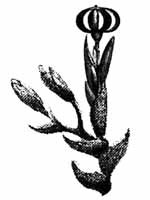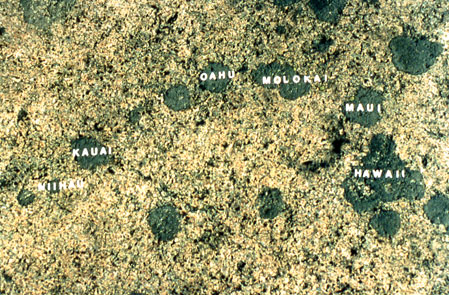 We step on them everyday. They surround us yet we pay no attention. As I was walking to the school this morning, thinking of what to do for a blog, I noticed all the little fuzzy green stuff in between the cracks of pavement, and then I looked up to find it on the trees, and really all over the place! I realized I never really gave much thought to mosses. They may be small and inconspicuous, but they are actually very important! How, you might ask? You're just about to find out.
We step on them everyday. They surround us yet we pay no attention. As I was walking to the school this morning, thinking of what to do for a blog, I noticed all the little fuzzy green stuff in between the cracks of pavement, and then I looked up to find it on the trees, and really all over the place! I realized I never really gave much thought to mosses. They may be small and inconspicuous, but they are actually very important! How, you might ask? You're just about to find out.Mosses are called Bryophytes (their classification). Lets briefly examine the four major moss groups....well, okay, lets mostly examine one of them. Go to this site about Bryophytes to learn more on your own.
Otherwise known as "peat mosses," these are actually some of the most important types of moss around. What's so great about peat moss? How about fuel! Yes, in Ireland, peat moss is burned for fuel and unlike burning fossil fuels, it can be a renewable resource.
 On a more personal note, peat moss is helping to fund my education!!!! What?! Yes, that's right...peat moss is essential in the growth of my dad's cranberry bogs. Cranberry vines grow in very acid soils on water-logged peat moss covered with lots of sand. And no, bogs are not always covered in water...in fact, the bogs only look like the picture at the left when you harvest them (which is of my sister and her high-school boyfriend). But this is about moss, not cranberries...so on to the next great thing about peat moss!
On a more personal note, peat moss is helping to fund my education!!!! What?! Yes, that's right...peat moss is essential in the growth of my dad's cranberry bogs. Cranberry vines grow in very acid soils on water-logged peat moss covered with lots of sand. And no, bogs are not always covered in water...in fact, the bogs only look like the picture at the left when you harvest them (which is of my sister and her high-school boyfriend). But this is about moss, not cranberries...so on to the next great thing about peat moss! Peat moss is also used for its antiseptic and absorptive properties. In Russia and Northern Europe, peat moss is heat treated so that it absorbs oil but not water, and for over 20 years it has been used to mop up small-scale oil spills! Fantastic! Peat moss is a habitat saver! It also purifies air and removes odors when mixed with bacteria that break down the stink, and can filter a whole bunch of other stuff, including septic tank sludge. And forget those horrible packing peanuts...use peat!
Peat moss is also used for its antiseptic and absorptive properties. In Russia and Northern Europe, peat moss is heat treated so that it absorbs oil but not water, and for over 20 years it has been used to mop up small-scale oil spills! Fantastic! Peat moss is a habitat saver! It also purifies air and removes odors when mixed with bacteria that break down the stink, and can filter a whole bunch of other stuff, including septic tank sludge. And forget those horrible packing peanuts...use peat! Since peat absorbs so well (it absorbs better than a sponge), Native Americans used to use it to line diapers and menstrual pads. And because of its antiseptic properties, Rusty Peat Moss was also used to treat diaper rash! Wow...diaper rash treatment and diaper in one...those guys were freakin' smart.
Since peat absorbs so well (it absorbs better than a sponge), Native Americans used to use it to line diapers and menstrual pads. And because of its antiseptic properties, Rusty Peat Moss was also used to treat diaper rash! Wow...diaper rash treatment and diaper in one...those guys were freakin' smart. Otherwise known as "Lantern Mosses." Can you tell why by the picture? I think these are the kinds I saw on my walk from the parking lot to the school this morning. These mosses can get majorly dried out and still survive. They grow exclusively on the surface of rocks, and are the most "primitive mosses." Oh wait...looks like they only grow in cold climates usually...and there are only about 100 species...okay...my search for the mosses I saw continues....
AKA "Nematodontous Mosses." I really had a hard time finding anything on this moss. Aha! Just found something. This moss is found in coniferous forests at a variety of elevations. It also has to have a male and female plant to reproduce, unlike other mosses. The only thing I could find a use for it is for stuffing upholstery.
(picture is not of Nematodontous moss...it's peat moss. Just thought it would be funny to put here)
Bryopsida
Also called "Arthrodontous Mosses." Okay, here it is....95% of mosses belong to this subclass. This must be where my sidewalk moss lies. These are the "true mosses." Truly fabulous.
I've discussed most of the economic importance of moss, and peat moss is truly a winner in that category. Moss is also important ecologically. Mosses help control water balance, nutrient flow, and acidity in soil. This is why it's usually found in your store-bought bags of potting soil. When we have horrible rainstorms, mosses keep the soil in place. And especially in Hawaii, they maintain high humidity (for happy orchids!). Birds and mice and other animals can use it for nesting materials and shelter.
Mosses (and lichens and liverworts) also help let us know what is going on with our environment over a long period of time. Their tissues can be sampled to reveal pollutants that have been in the air. Some can also absorb chemicals in the soil.
Here's a great site on the importance of mosses, liverworts, and lichens.
And that concludes my lesson on mosses. Maybe you'll show a little more appreciation for it the next time you squish it with the bottom of your shoe. I know I will!





No comments:
Post a Comment